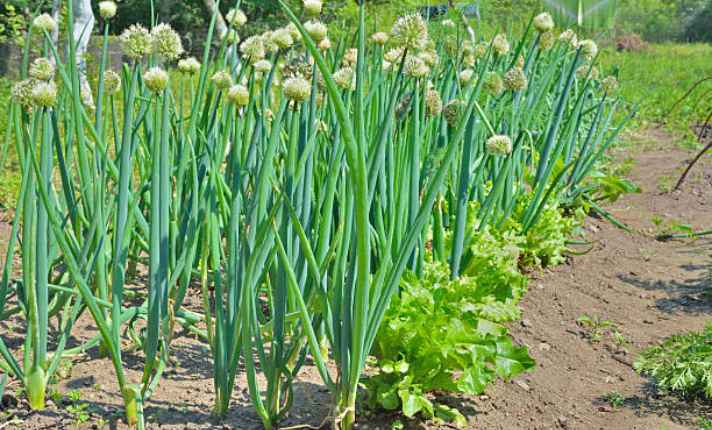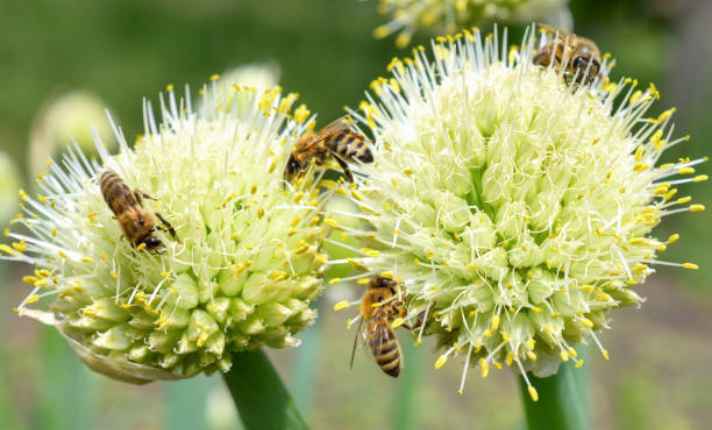Onions grow through five main stages: germination, seedling, vegetative, bulb initiation, and bulb development to maturity.
It all begins when seeds are planted in spring. Roots start growing and green, hollow leaves appear. These early stages help the plant get strong and ready to make a bulb.
The bulb begins forming underground when the plant gets the right amount of daylight and water. Temperature and soil quality also play a big role. As the bulb grows, it stores nutrients that help the onion mature.
By autumn, the leaves dry out and the onion is ready to harvest. After pulling them from the soil, the bulbs are dried and stored in a cool place.
To grow the best onions, it’s important to protect them from pests and diseases and care for the soil at every step.
Onions are a beloved vegetable found in cuisines worldwide, Their versatility in cooking stems from the unique flavor and texture bulb onions provide, But what exactly goes into growing these tear-inducing bulbs? Understanding the life cycle and growth phases of the common bulb onion gives insight into proper care for successful cultivation
The Journey from Seed to Harvest
The onion growth process begins when an onion seed is planted. Germination occurs within 7-10 days when temperatures are between 68°F to 77°F. The seedling then enters a period of vegetative growth lasting 2-4 weeks. True leaves form and the young onion plant establishes itself.
Bulb formation commences once the onion has 4-6 mature leaves. This stage lasts 70-120 days depending on the variety. The onion begins directing energy towards swelling the underground bulb located at the base. As the bulb enlarges the soil is pushed upwards. Above ground the leaves turn yellow and fall over when the bulb matures. The onion is now ready for harvesting.
Regional Variations Exist
Day length affects what varieties perform best in different geographical regions. Short-day onions bulb with 10-12 daylight hours, suiting southern regions with milder winters. Long-day onions require 14-16 hours of sun and grow well in northern zones with long summer days. Day-neutrals fall between needing 12-14 daylight hours. Matching the onion variety correctly prevents stunted and misshapen bulbs.
Two Phases of Growth
The onion lifecycle contains a vegetative phase and a bulbing phase. During vegetative growth, the above ground green leaves collect energy via photosynthesis. This energy fuels the later bulbing stage, so ample foliage is desirable. The more substantial leaves the plant produces, the larger the resulting bulb can grow.
Bulbing begins once the onion has sufficient leaves. Energy gets redirected below ground to expand the edible bulb. Vegetative growth halts as the plant concentrates on maturing the bulb. Proper care while bulbing includes reducing watering frequency and providing phosphorus-rich fertilizer.
Harvest Timing is Key
Determining onion maturity takes experience. Under-mature onions taste bitter and overly mature bulbs risk rotting. Signs of readiness include:
- Top leaves turning yellow and falling over
- Exposed bulb emerging from the soil
- Folded, drooping foliage
Use a digging fork to gently loosen soil and lift bulbs out. Curing for 1-2 weeks in a dry, well-ventilated area maximizes storage time. Then store cured bulbs in a cool, dry spot. With the right care, they will keep for months.
Common Growing Challenges
-
Stunted Growth – Lack of nutrients and poor drainage inhibit growth. Test and amend soil pH and fertility regularly.
-
Leaf Discoloration – Yellowing indicates insufficient nitrogen. Water stress and pests also cause color changes.
-
Wilting Plants – Overwatering or underwatering alike can make leaves droop. Check soil moisture and water appropriately.
-
Misshapen Bulbs – Erratic moisture levels and compacted soil prevent proper bulb formation. Loosen soil and irrigate regularly.
-
Pests/Diseases – Thrips, onion maggots, and fungal infections like downy mildew are potential threats. Remove infected plants promptly and use preventative sprays.
Tips for Success
-
Prepare fertile, well-draining beds with compost/manure worked in
-
Sow seeds early, allowing 10 weeks for seedlings before planting out
-
Maintain consistent 1-1.5 inch irrigation until bulbing starts
-
Fertilize regularly with balanced, nitrogen-rich feeds
-
Allow proper curing time and store bulbs in ideal conditions
The Entire Lifecycle

Q: How Many Onions Grow from One Bulb?
A: From a single bulb, you can grow one onion, but each bulb will produce seeds that can be planted next year. Onion size depends on growing conditions and variety.
For the cheapest supply, grow your own onions from seeds or bulbs, ensuring you have sufficient space, soil, water, and sunlight.
Flowering Stalks Begin
In the second year, onions experience a unique phenomenon. When temperatures rise, a central stalk starts to grow. This stalk eventually produces buds.
As buds emerge, they create a floral display. These flowers are often white or purple. You might see them in clusters. They are delicate and small.
Bolting happens when onions naturally trigger flowering. This uses a lot of the plant’s energy. If you don’t want this, you can cut the stalks early. This helps keep the onion in its vegetative growth stage.
Onions are biennial plants. In the first year, they focus on growing green leaves. In the second, they switch to flowering. This is a part of their lifespan.
Cold or extreme heat can trigger bolting. To avoid this, plant onions during the right seasons. Variety and category also affect when blooms happen.

Pollination is a key part of their life cycle. In the pollinating stage, onions produce flowers. These flowers are important for seed production. Bees, butterflies, and winds help to pollinate the flowers.
Cross-pollination occurs when insects like bees and butterflies move pollen from one plant to another. This helps create a new generation of onions. Some onions are self-fertile, meaning they can pollinate themselves without insects.
Pollination usually happens in the next season. The female parts of the flowers get fertilized by the pollen from the male parts. These fertilized flower heads will then make new seeds.
The pollination process is essential for a bountiful production of onions.

In spring, onion seeds are released from flower heads. These black, hard seeds are collected and stored in a bag. When planted in cool places, they germinate. Over weeks, the onions develop.
As they grow, their color changes. The outer layers turn paper texture and become fully matured. By fall, the onions are ready to be harvested.
Their weight increases and onions are pulled from the shade of the soil. Collect and store them for the season.

During senescence, the onion reaches its final growth cycle. Leaves turn yellow and then brown, starting to wither. Cold weather and other environmental conditions trigger this change.
In this reproductive stage, the plant uses its energy reserves for seed production. Human intervention helps by keeping onions indoors during winter.
Animal activity or wind can make the plant collapse, naturally dispersing seeds for future plantings.
Planting Onion Bulbs: A Complete Guide From Start To Finish
FAQ
How long does it take for onions to grow from bulbs?
What are the stages of onion growth?
The 3 phases of an onion are the vegetative stage, the bulbing stage and the bolting stage. While in the vegetative stage, the plant focuses all of its energy on above-ground leaf production. The larger the leaves, the larger your onion bulb will be.
What triggers onion bulbing?
Onions will start bulbing once they’re receiving enough sunlight. Bulbing is dependent on daylength and temperature, not the size or age of the plant, so choosing the proper varieties for your area is critical.
